I deem that shelter is the most important primary need which you can supply yourself. You certainly must master the secrets of shelter if you want to be confident of enjoying yourself in the outdoors and surviving.
No doubt all of you have heard about Maslow’s ‘hierarchy of needs’. You will (perhaps) note that amongst the four ‘physiological’ needs he lists is ‘Homeostasis’, ie being able to maintain a constant temperature, something you may take for granted being a mammal – but that only means you have not been put to the test!
Last year (2021) I contracted a something (a virus?) in hospital as part of an unsuccessful (for me) knee procedure (radiofrequency ablation) – before I ‘bit the bullet’ and submitted to a complete knee replacement (which is going quite well now six months out, thank you. See A New Knee). I am easily doing 10-15,000 steps a day at the moment on our steep hillsides chasing lambs.
No-one thought to test me for covid as my symptoms were a loss of homeostasis and acute aches and pains in many joints (but not the knee)! It went on for six months with me simultaneously shivering and sweating until I took a four day course of Ivermectin (sheep drench) which cured it within 24 hours – so who knows what it was?
It was very unpleasant but not life threatening, as a failure of homeostasis as a result of exposure (hypothermia) is likely to be. I have witnessed the latter in a number of people over the years, most of whom (luckily) were able to be saved (especially my wife) – but action needed to be taken quickly as they were declining unbelievably fast. NB: Get a shelter up and get them into it and wrapped up warm – Pronto!
Shelter works because air is such a good insulator (and a poor conductor). It is the presence of trapped air in your home’s wall and roof spaces (insulation), likewise in your puffer jacket and sleeping bag which slows the egress (and ingress) of heat. Water by contrast is a much better conductor – 20 times better in fact! So, you will lose heat if you are wet that much more quickly than if you are dry.
The loss (or gain) of heat is not an absolute though. The phenomenon (like so many others) is about ‘rates of change’. If you absolutely stopped the egress of heat from your body its own heat production would ultimately cook you. The ‘trick’ is to slow the incoming or outgoing heat to a comfortable and manageable level.
This is ultimately what ‘R-ratings are all about. They could also be expressed in watts per minute of heat moving in or out, and as with so many such measurements they are a bit counter-intuitive (like shotgun gauges and wire) so that the lower number represents fewer watts per minute of transmission – and vice versa.
The ‘secret’ of effective shelter is to keep those watts per minute within your body’s ability to replace them, sometimes in trying conditions. The two key aspects of shelter are creating an air gap above you so you are no longer in contact with water (rain), as a wind barrier to reduce wind chill from itself stripping you of heat and if you like a toasty fire to warm you up (as I do) then as a means to reflect the fire’s heat onto you, particularly onto your back – which is usually facing away from the fire.
In one of my ‘Fire Shelter’ tents I am normally able to sit comfortably in shirt sleeves whilst outside the tent the temperature is below zero (Celsius) and the storm rages as much as it likes – particularly if I use a Fire Umbrella to prevent the fire from going out.
Here out front of my Grey Flyer tent on a winter’s night. No, I have never come even close to setting fire to my tent. It is at least 5′ away – and carefully managed Also the wind is always blowing away from the tent:
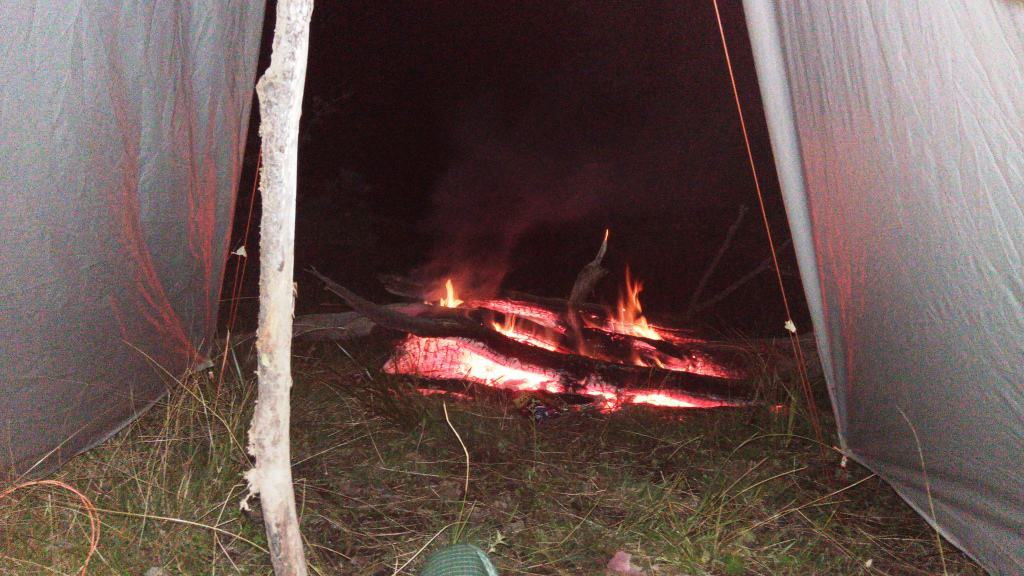
You may wonder what I consider the minimum shelter needed (since I am theultralighthiker). You should note this Raincoat Shelter (since this may be all you have. It may save your life though it is just a tad exiguous. The Raincoat Swag is also a convenient way to carry your raincoat so it does not fall down around your ankles.
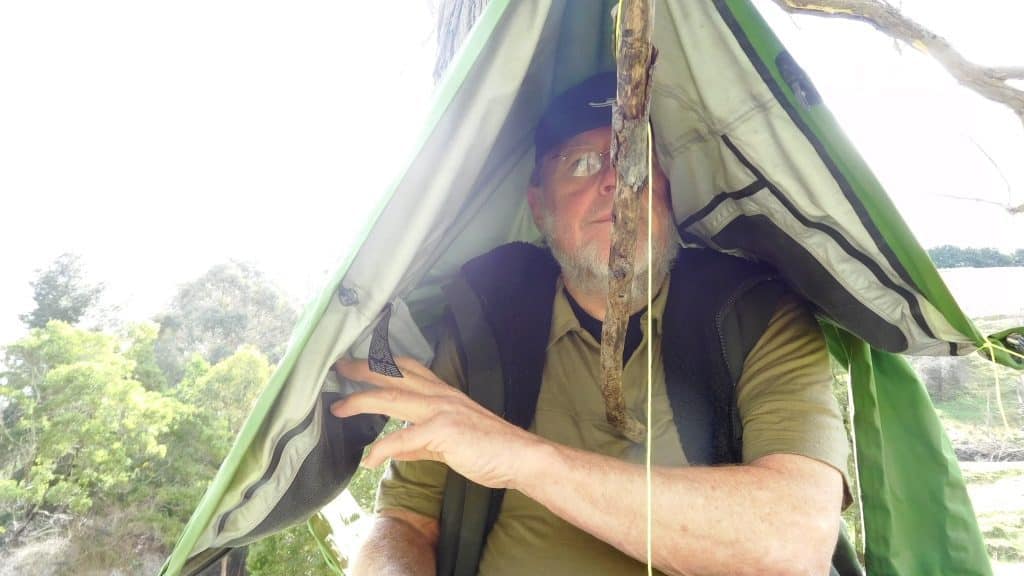
You should also consider the use of the humble mylar space blanket as a shelter. I have survived a sub-zero snowstorm overnight wrapped in one at above 1,000 metres (in quite ordinary winter day clothes) when the ground about me was frozen hard as iron. (I made a bark platform to sit myself and my feet on). It can also be pitched (like a poncho – as I explain here: Pitching the Poncho.
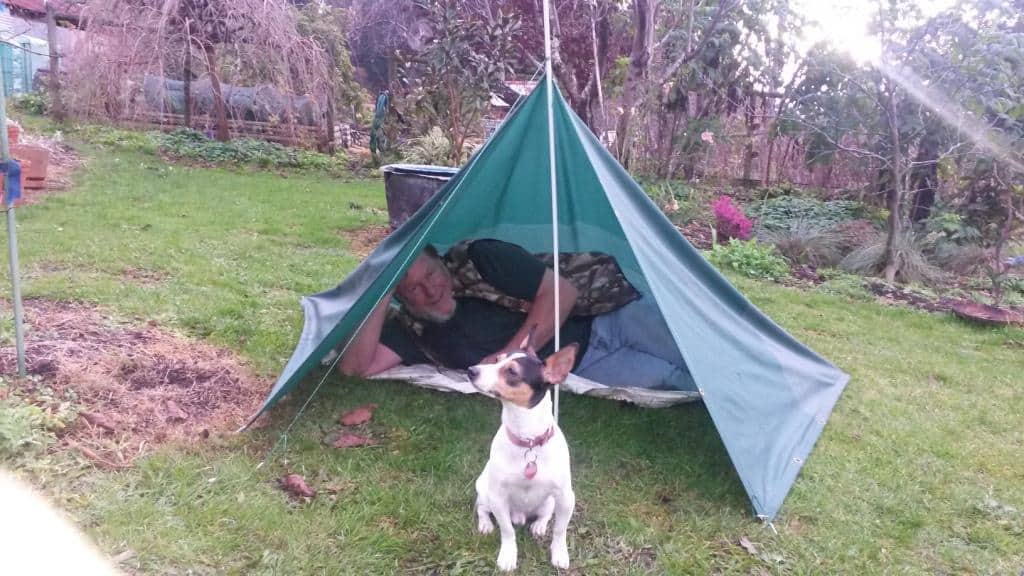
Otherwise I consider a poncho to be a pretty minimal shelter – but pitched (as explained) to create that air gap and wind-break – or if you must be walking, try placing a sheet of bark across your shoulders as insulation from the cold rain. You can also have a fire out the front.
I am only a little over 5’6″ (now) having perhaps shrunk a bit. My wife, Della is even more ‘vertically challenged’ at a very handy 5′, so we both/either fit comfortably under the ‘standard’ 7′ x 5′ poncho. If you are ganglier than that you might need to seek out (or make) one which is a bit longer.
My Holeless Poncho Shelter (photo above) is an improvement on the normal poncho and has evolved into the Pocket Poncho Tent (below), patterns for both of which I will soon post so you can make your own.I will also be making a new one which will fit both of us!
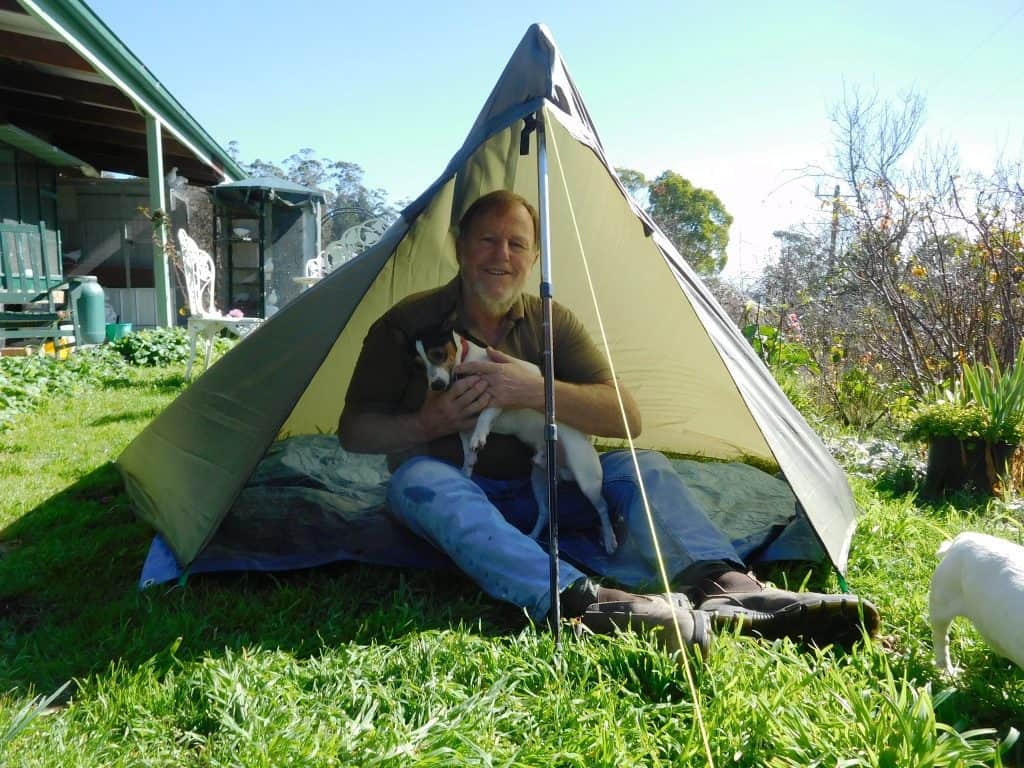
Here it is Packrafting the Upper Wonnangatta:
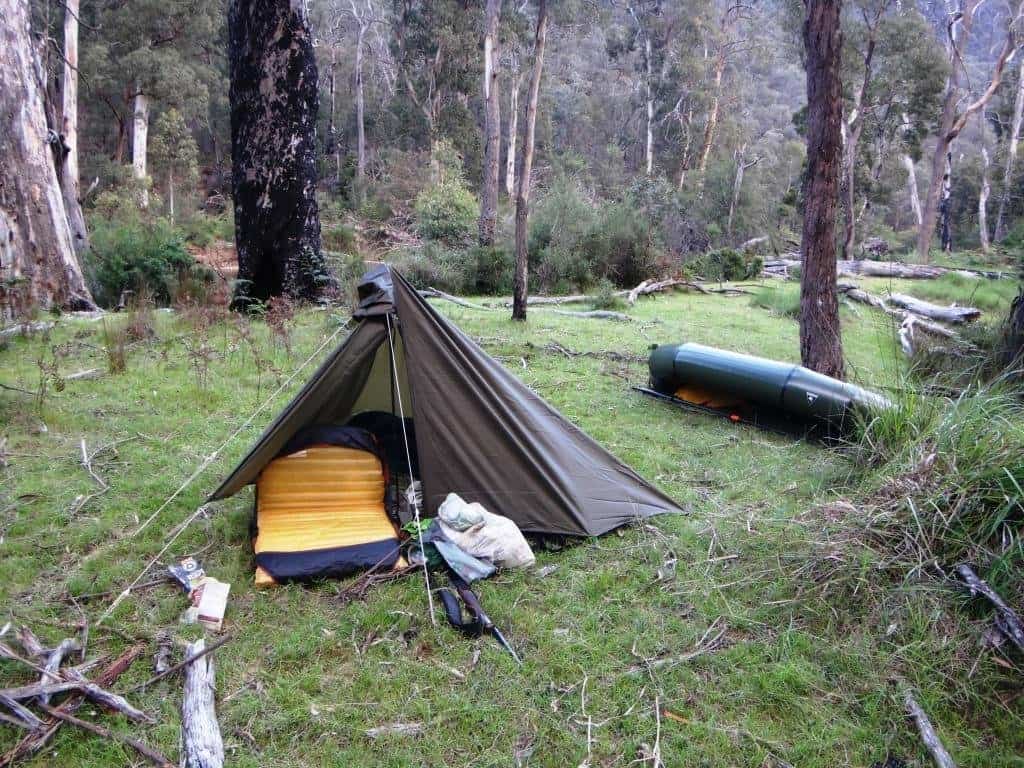
I have tried to pitch a poncho as a hammock tarp but the rectangular shape does not ‘sit’ well and the very narrow two ends made me nervous about how waterproof it might be in blustery conditions so I decided to /morph my holeless poncho into a 7′ x 7′ holeless poncho tarp. When used as a poncho the extra 2′ is simply folded back, making the area over your head and shoulders double – just that much more waterproof (and warmer).
Mind you when I first tried a Hennessy I thought his ‘asym’ tarp was too narrow too but having slept in one for many nights (eg waiting for hounds to come in) often in pouring rain I know this is not the case. Rain falls mostly vertically and anyway only from windward. You need very little ‘lee’ to stay quite dry. Its progress is also slowed/stopped by quite sparse vegetation, as you will know if you have ever sat under even a (quite spindly) wild cherry in heavy rain some winter’s day listening to the echoing hounds working the valley below.
I can still remember stopping regularly with my father when I was a small boy under a magnificent Morton Bay Fig on a lonely hillside near Paterson when out on our weekend hunts. I imagine it is still there. We have one in the back garden which my son, Bryn planted nearly 35 years ago. It is wonderful shelter now for sheep and lambs on such awful wet days as we have been having here lately. Cruel weather for lambs it has been but it presages a good summer (for sheep – and bushfires).
Here is ‘Bryn’s Tree’ today over 30 years later. It was a tiny scrap of tube stock from Ripponlea. I remember when he planted it (with a tree guard around it) in what were then the hound yards. I said one day he would be climbing it. It got away very quickly early on but then we had that 10 year drought in Gippsland and it stalled. Meanwhile our old hound Harpoon harassed it quite a bit. About a year before the drought ended it must have pushed its roots deep into some water source far below as it shot from 10′ to 30′ in a year. Since then it has filled out to over 60′ -and he has climbed it now! The hounds are long gone now thanks to the government ban in 2005, alas. After over two centuries of our family hunting with foxhounds in Australia. You can’t imagine how bitter I still feel about that.
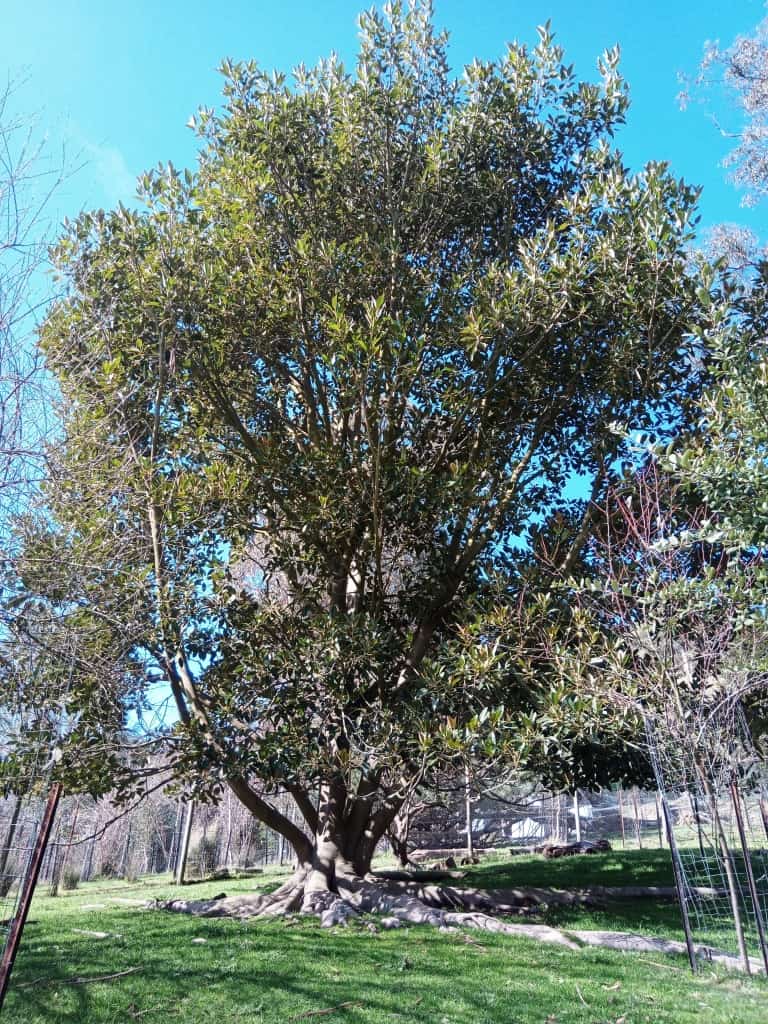
Back in the middle 1950s superphosphate was just beginning to appear in thick polythene bags. My father always had a couple of such pieces of cast-off in his ‘dilly-bag’ which we could drape around our shoulders to keep the core of our bodies from becoming soaked – of course that is the most important thing. Never let your core become chilled. These scraps of plastic were probably only 30″ by 18″ ( 75 x 45 cm).
(What is/was a ‘dilly-bag you wonder? What I refer to is usually a 1-2 bushel jute bag which grain etc used to come in. Folks used to tie a length of twine around one corner then (having filled the bag with their necessaries, tie off the top with the other end of the twine. This was then slung over the head onto the shoulder and carried on the opposite hip. What we used before there were backpacks – Americans would call them ‘gunny-sacks’).
Neither is it very hard to find (or make) somewhere dry up the bush where you can survive overnight. When I was walking along a river bank with the Deer Hunter’s Apprentice a few year’s ago I was able to point out a dozen such places in the course of less than a kilometre. Hollow or leaning trees and logs, under fallen trees…etc.
For years deer hunting every winter’s weekend all I carried for shelter was one of those $2 plastic film ponchos you can buy anywhere in my beast pocket. There is a mylar one available from Coghlans now which while a little dearer is warmer. I have often spent all day (up to 12 hours) tramping through wet bush in pouring rain wearing one. They do get pretty shredded in such circumstances but they will keep your core (relatively) warm and dry – which is essential.
Such a 7′ x7′ silnylon tarp as I described earlier is 49 square feet or approx 5 1/2 yards so at 1.3 oz/yd2 it will weigh just over 200 grams including gross-grain tie-outs at each corner and half way along the edges. The velcro or waterproof zips to convert it to a poncho will add another 25 grams at most. In Ripsopbytheroll’s .77 oz/yd2 Mountain silnylon it will only be 120 grams (plus zips) – and pretty much fit in your breast pocket! See 7 x7 Poncho Multi Tarp
Here is my old (2 oz/yd2 – 300 grams!) 7′ x 7′ tarp one pitched in front of a warm fire along the Mt Darling Creek back in mid-winter 2010. I have it pitched steeply so I can stand up if I want in front of the fire but it will still keep me dry in the rain (which would be coming from behind me, so too the wind). You see what I mean about the shelter being so good I can sit in shirtsleeves whilst the temperature outside is probably minus 5-10C!
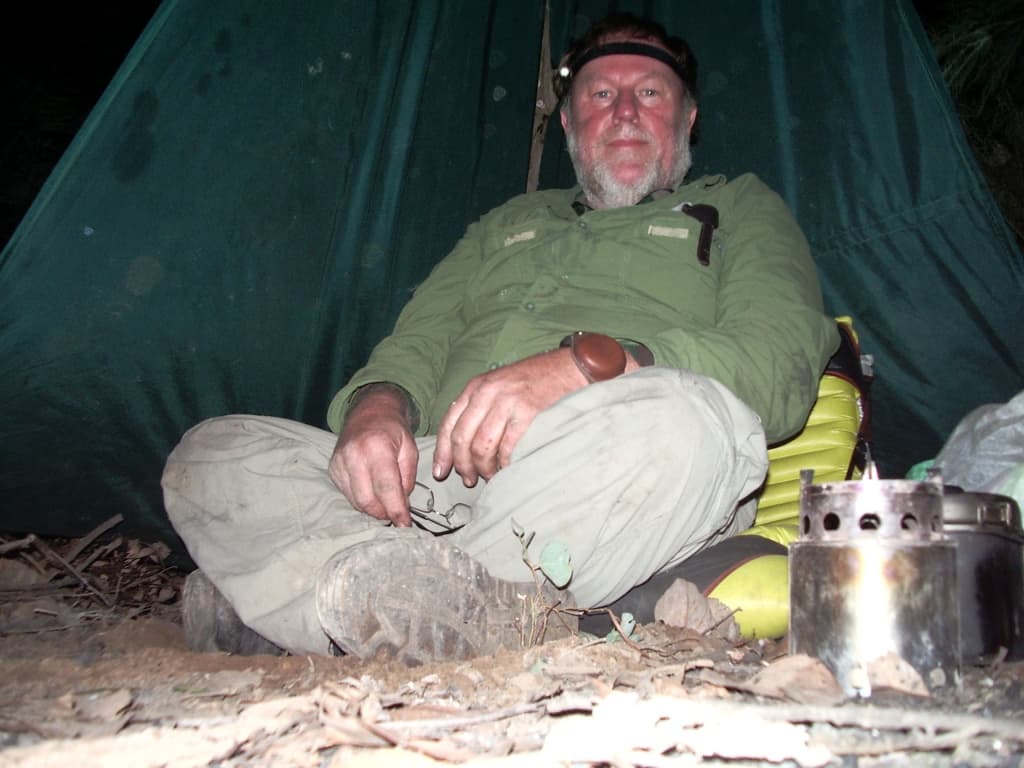
When I am going to bed I drop the pitch down so the open peak is no more than 1 metre above ground to increase the coverage compared with the view shown above, and usually sleep sideways.
If you have some doubt about whether such a small tarp is enough to keep you dry you need to consider that it is 10′ in diagonal – and you are probably 6′ at most. Two feet of ‘overhang’ at each end of yourself will be plenty. If you sleep sideways the forward overhang will be much more (up to 5′) – and there is ample room in the ‘back’ corner for all your gear where it is also very accessible.
Such a small tarp is also enough to keep you dry in a hammock. I have spent many nights sleeping under this one. On one such night years ago I was (unusually) camped with a couple of other hunters who were nearby in a tent under a tarp yet became soaked through. In contrast I enjoyed an uninterrupted night’s completely dry sleep. It was also a very windy night on a sub-zero mountain top but the tarp never budged.
A hammock can be as little as 150 grams too complete with suspension (See Ultralight Hammock). My Hummingbird one (shown here at Dusky Sound Fiordland NZ) is more like 200 grams (with suspension).
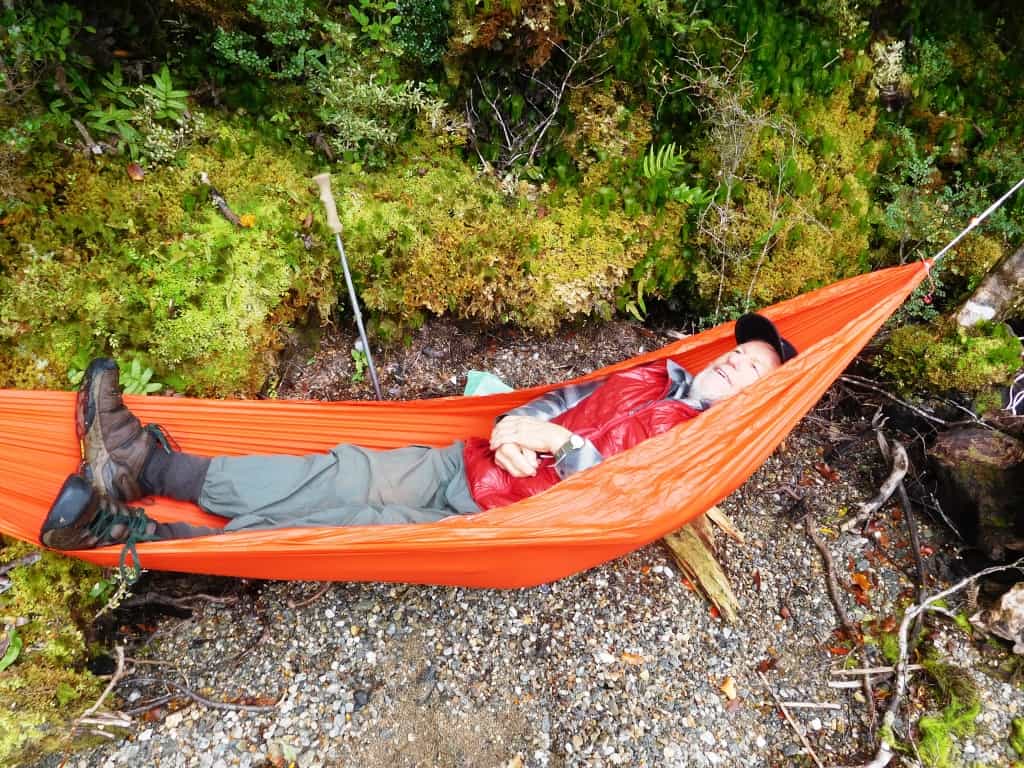
I am able to just use my inflatable sleeping mat and sleeping bag for insulation in one in the coldest weather, and have done so more often than I care to estimate – hundreds of times anyway. I will soon post a simple DIY hammock modification which helps keep the sides of the hammock from pressing against your shoulders/arms.
Below is my 8′ x 8′ cuben tarp used as a hammock fly. Spot is enjoying the hammock.
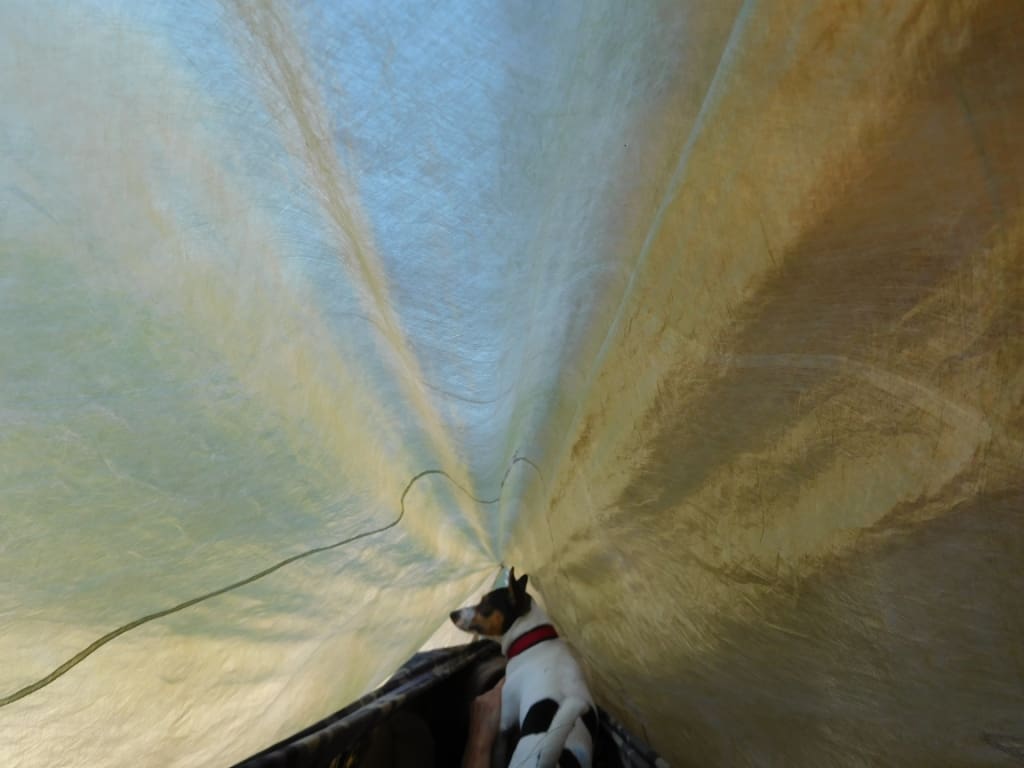
This simple 7′ x 7′ tarp then can be used as both a ground and hammock shelter as well as a raincoat for a weight penalty of as little as 250 grams (including the hammock). I would add to that my below zero Celsius sleeping bag (at just over 500 grams and my sleeping mat at just over 300 grams) – so, a pretty cosy set-up for a weight penalty of 1050 grams all up! It is easy to carry so little in a pack which weighs only 300 or so grams.
I also have an 8′ x 8′ cuben fibre tarp (with ‘wings – photo below) which I can set up as a tent type shelter (for two) or as a hammock tarp (for two). As it is in a cuben fibre which is less than .6 oz/yd2 it only weighs about 200 grams in a bag with its tent pegs. I do reserve it for ‘special’ trips now as the cuben fibre is so delicate. It is a good thing to take along as a spare tent/shelter just in case the first one blows away (or something).
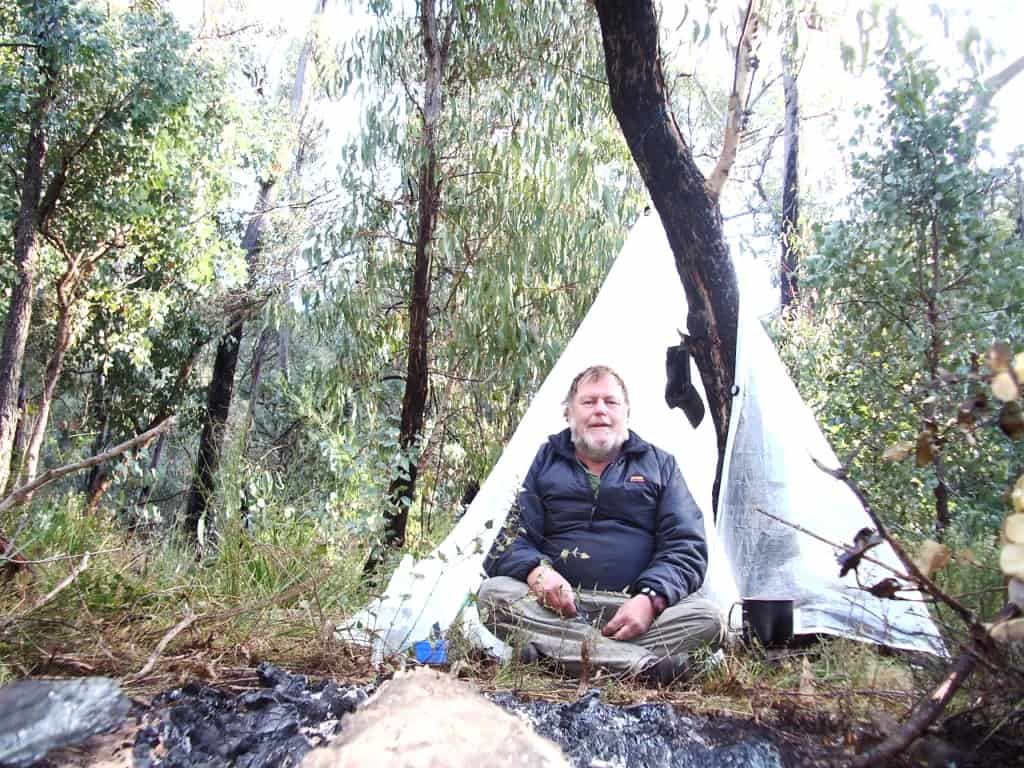
The ‘wings’ almost close the door of the tarp (Photo 2010).
I/we carry two satellite communicators for the same reason. We took it on our week long walk on Tasmania’s South Coast Track for example where there is no other shelter and conditions are always within the ‘Roaring Forties’, but we almost always used the larger tent below:
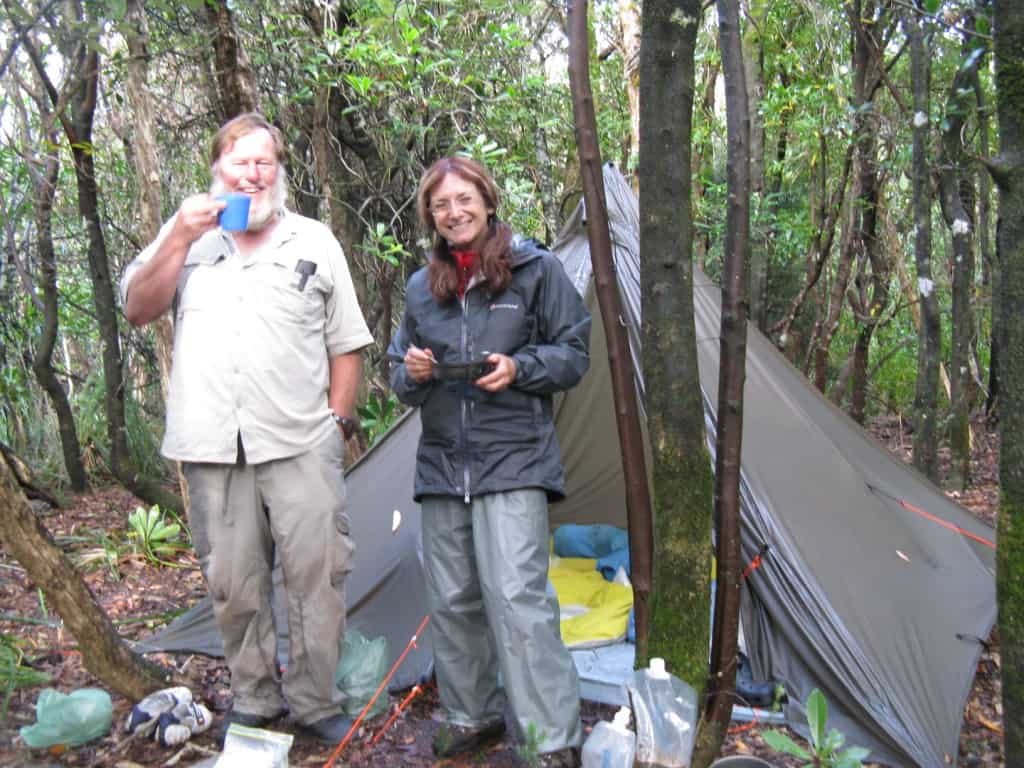
It is light enough for Della to carry in case we are ever separated but I may substitute a new 7′ x 7′ model when I make it for lightness and as it will also mean we have a spare raincoat – something else which you can’t afford to have go missing – but they do! See 7 x7 Poncho Multi Tarp
A BTW: a space blanket can be made into a holeless poncho as above with just the aid of some sticky tape – the ends of band-aids will do. You should always carry a mylar space blanket.
If you carry such a tarp and a hammock they make a great shelter on a wet day when you just have to stop for a break for lunch or to warm up, make a hot cuppa etc. The constant passage of ice-cold rainwater over your rain gear really drags the heat out of you and if you have to stop for a break you will otherwise be freezing, but the shelter of just this simple roof will warm you up in no time as it did Della in this post The Importance of a Roof. She was otherwise verging on exhaustion/hypothermia as she has on two other occasions.
Woodshed near the Track Burn South Coast Track Fiordland NZ. It was so cold and wet it rained inside the camera – as you can see:
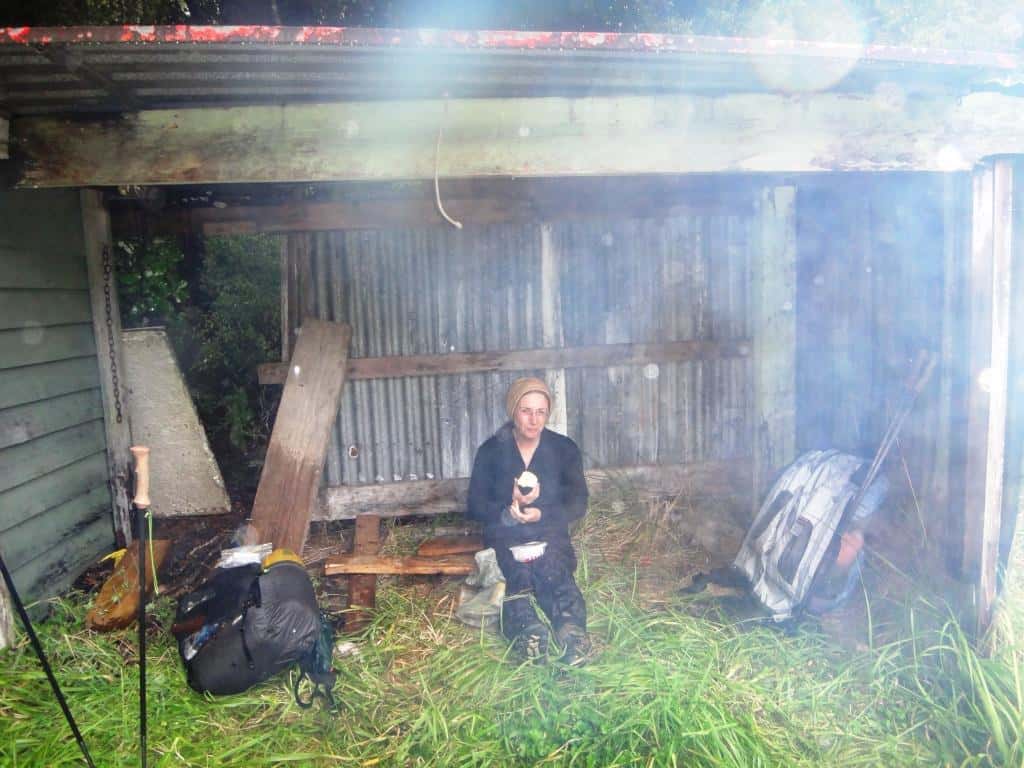
It is amazing (particularly in mountain areas – but I have also encountered it in windswept wet areas along the coast) how quickly the weather can change from acceptable, even warm and sunny to bitter cold and blizzardy conditions.
We encountered such conditions on the South Face of Mt Baw Baw one day (for example) and if I had not been able to get Della quickly into the shelter of one of my tents and into some warm clothes and with a hot cuppa inside her she was going downhill fast…On this occasion I reckon the temperature dropped from perhaps 18C to minus 5-10C in a matter of five minutes, more quickly than you could get your layers out of your pack and put them on (and an icy rain had begun ). This has happened to me several times. If you are not prepared for it and able to utilise shelter in a hurry you may be in dire trouble.
I am not such a minimalist that I insist on such an exiguity as a 7′ x 7′ tarp (or less) . My Grey Flyer tent (is huge) yet has a roof which weighs 310 grams. I am soon to make a new version of it where I will shorten it a bit and add a catenary curve to the roof line so that it ‘sits’ even better. Actually it is not sitting at all well in the photo below (and Spot has scuffed the floor away from the sides), but you can be obsessive about such things.
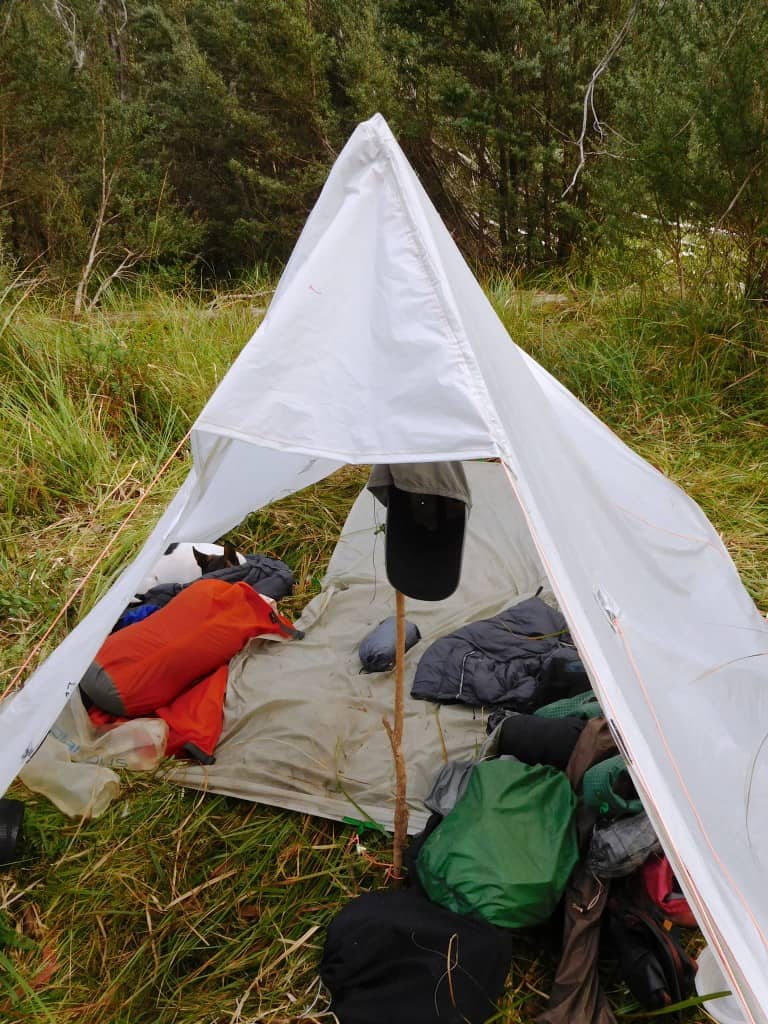
A 6″ shortening will take 5 square feet from the roof (and floor) and the cat curve will reduce the area by a further 2 square feet, so three quarters of a yard less. I may be able to shorten it by a whole foot, but I do not want it to become cramped. If I make the tent in the .77 oz/yd2 fabric already alluded to it would weigh 207 grams less the 17 grams (in the size reduction) ie 190 grams. A big (or little) saving.
Of course I also make a bathtub type floor for it (which will add about 100 grams – the one in the picture above has come loose from the tent – courtesy of Spot. I have added some extra Velcro to better hold it in place since then) but it is unbelievably more luxurious than the simple minimalist 7′ x 7′ tarp shelter with maybe a piece of Polycro (below) as a floor/groundsheet.
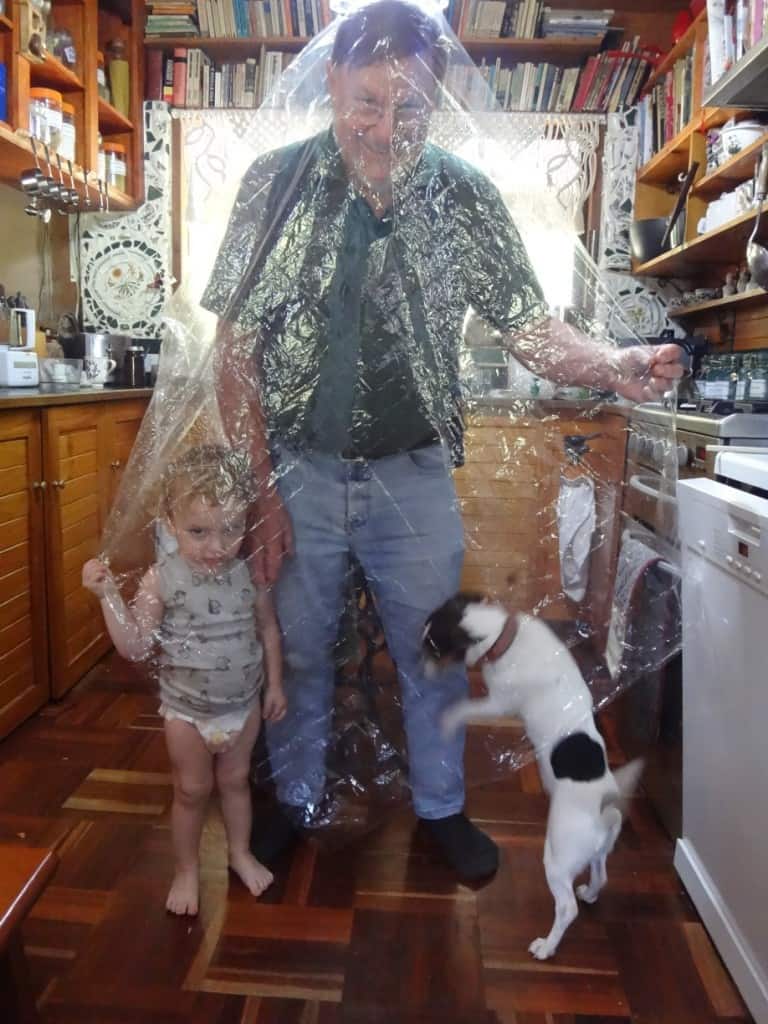
I will then (since I will make it in dark olive – which deer ignore) have to think of a new name for this foreshortened tent which will weigh under 400 grams all up! A prince amongst shelters.
Of course it has the added advantage that it will accommodate two (plus dogs) and can shelter two hammocks under it – so it will be much more suitable for Fiordland travel. We do intend to return to the South Coast Track and Dusky Track in the not to distant future.
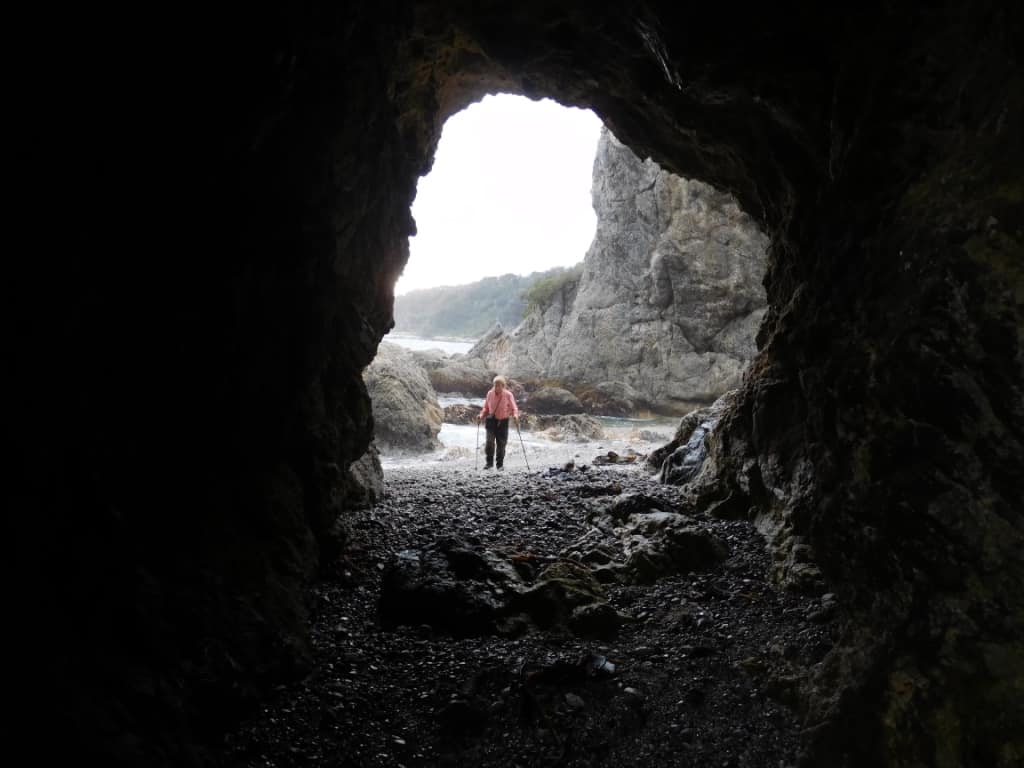
A companion piece perhaps: The Secret of Fire – at least, after shelter, warmth is often the next most important thing.
See Also:
